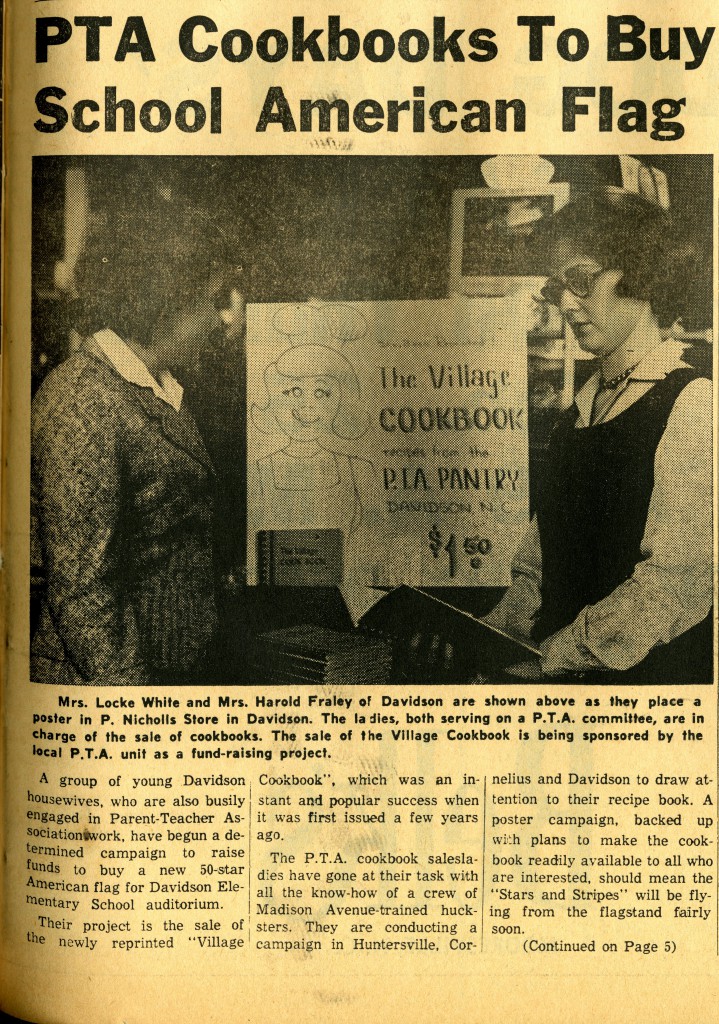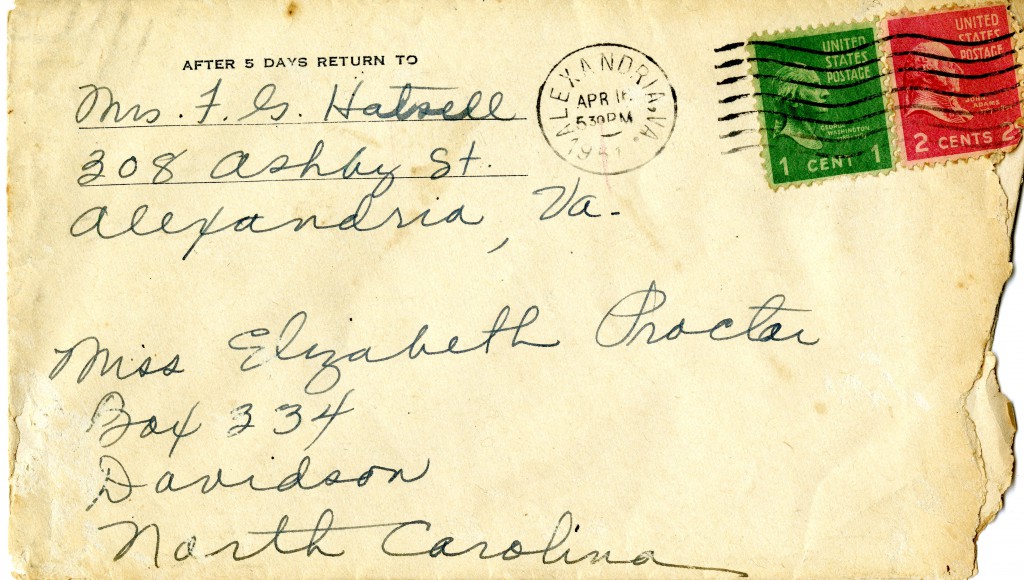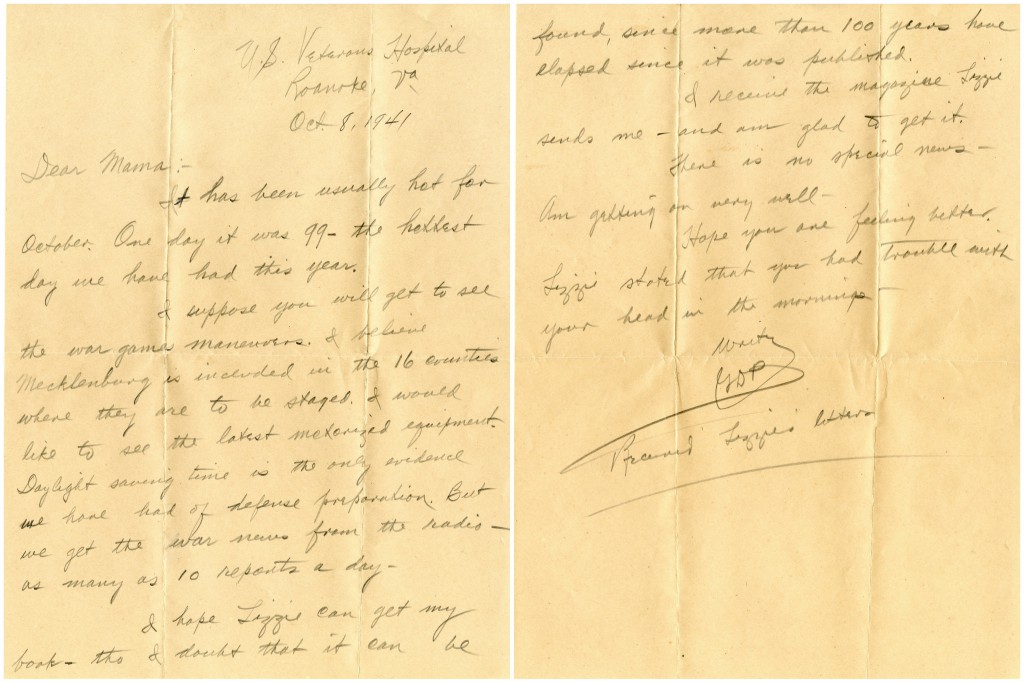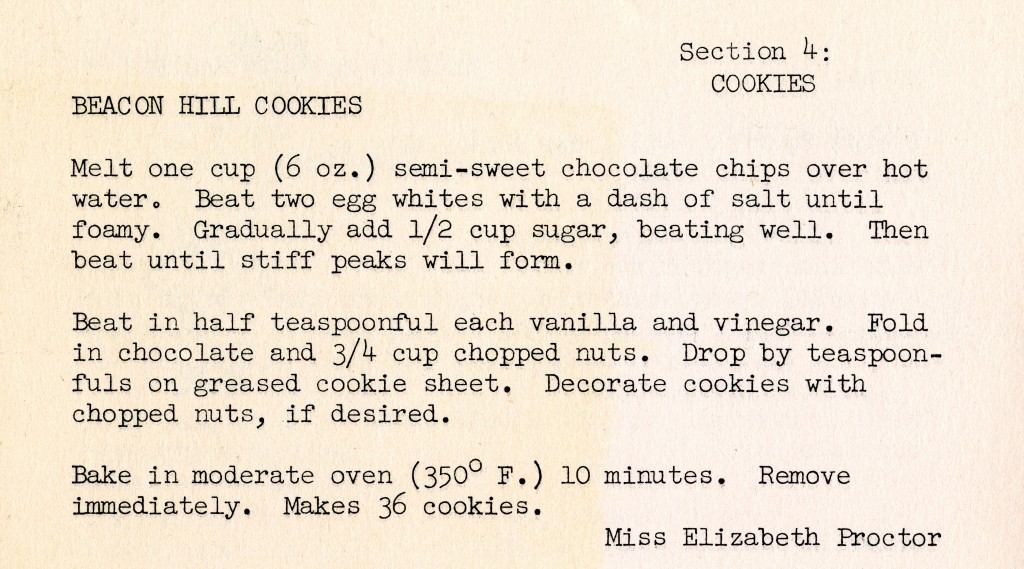When we began our Recipes from the Archives blog series a year ago, the Archives & Special Collections team had a few aims: we wanted to experiment with a new way of making our archival collections accessible and interesting, and we (well, mostly me) wanted to learn more about historic cooking and connect with small town southern culture. But it wasn’t lost on us that the vast majority of the recipes in our collections come from women – in fact, shining a spotlight on the women of Davidson was an explicit goal. March is Women’s History Month, so it’s an excellent time to reflect on how our archival cooking experiment has been going since the first entry in March 2015 (Ice Box Pudding #1), and share some of the research challenges we’ve encountered.
For this week’s recipe, I revisited the 1965 The Village Cook Book: Recipes from the P.T.A. Pantry, Davidson, North Carolina and selected Elizabeth Proctor’s “Beacon Hill Cookies.” The members of Davidson’s Parent-Teacher Association gathered recipes from women in the town and compiled a cookbook as a fundraiser for an American flag for the auditorium and a recorder and filmstrips for the library of Davidson Elementary School.

“PTA Cookbooks To Buy School American Flag,” from the February 25, 1965 issue of the Mecklenburg Gazette.
The PTA’s Village Cookbook was organized by and contributed to solely by women, and one of the challenges our team faces when selecting recipes is figuring out who each individual woman was. If she was married, the recipe-contributor is generally referred to by her husband’s last name and first and middle initials. Many of the women active in town organizations that compiled cookbooks were wives of faculty members, and their records are the easiest to uncover – we have employment records and reference files for all past faculty members, which often includes information about and pictures of the faculty member’s spouse. We have other sources to gather further information about spouses of faculty members, as well as women living in the town who had no employment connection to Davidson College – the published histories of the town and college (Cornelia Shaw’s Davidson College, Mary Beaty’s A History of Davidson College, and Jan Blodgett and Ralph Levering’s One Town, Many Voices) often includes stories about women whose names crop up in our cookbooks, and if the individual was active in town clubs or societies, we can often learn more about her through the manuscript records we have from the town Civic Club, Senior Center, or one of the town book clubs.
In the case of this week’s recipe-submitter, Elizabeth Proctor, information was harder to find. The Proctor family collection consists of two letters, one to Elizabeth from her mother, and one from her brother G.D. Proctor to their mother. There is not a lot of information about the family – we know that members of the family lived on South Main Street from roughly 1919 until at least 1965. Elizabeth’s name did not come up in any of my searches through town club rosters, or in any of the Davidson histories.
The two letters themselves also do not reveal much information – G.D.P. sent a letter to his mother from the Veteran’s Hospital in Roanoke, Virginia on October 8, 1941. The letter contains interesting tidbits about war games across North Carolina in advance of the U.S.’s entry into World War II, and contains references to his sister, Elizabeth:
“I hope Lizzie can get my book – tho I doubt that it can be found, since more than 100 years have elapsed since it was published. I received the magazine that Lizzie sends me – and am glad to get it… Lizzie stated that you had trouble with your head in the mornings. Writes, GDP Received Lizzie’s letters”
The other letter in our collection is from Mrs. Proctor to Elizabeth, sent April 16, 1951 from Alexandria, Virginia. The contents of the letter concerned buying clothing for Elizabeth, and Elizabeth’s health – her mother mentions a fever and the cold weather possibly being to blame.

The envelope from the April 1951 letter from Mrs. Proctor to Elizabeth – note the P.O. box, as going to the town post office to collect mail has remained a tradition in Davidson today.
Outside of these letters, we know very little about the Proctor family. The 1920 census tells us that Elizabeth’s parent’s were Adolphus R. and Phinny R., and her father worked as a carpenter. The rest of the family consisted of her older brother Shirley R., and younger siblings Cynthia E., Dewy G. (likely the G.D.P. from the letter in our collections), Janice M., Sidney E., and Helen C. All family members were listed as being born in North Carolina, and Elizabeth and Cynthia both gave their occupations as teachers at the “graded school.” By 1930, the census only records Adolphus, Phinny, Elizabeth, Janice, and Sidney as living in Davidson, and Elizabeth no longer listed a profession. Elizabeth was 32 in 1930, making her probable birth year 1898.
Other news that made it into town/college newspapers and notes from Mary Beaty’s A History of Davidson College: Sidney Proctor made the fifth grade honor roll in 1919; in November 1922, Elizabeth’s younger sister Helen participated in a Girl Scouts entertainment; in March 1923 Elizabeth visited “friends and relatives in Denver” (likely Denver, North Carolina, from The Davidsonian); and in 1926 Helen Proctor attended “Eastern Carolina Training School at Greenville, SC” (Also from The Davidsonian, possibly referring to the forerunner of East Carolina University, the East Carolina Teachers Training School in Greenville, NC). Records of the Davidson College Presbyterian Church list Elizabeth and a Mrs. G.D. Proctor as members. We also came across references to the family phone number through copies of Southern Bell Telephone Company records.
I chose to make Elizabeth Proctor’s recipe for Beacon Hill Cookies from the PTA cookbook because I was intrigued by the title of the cookie – I used to live in Boston, and worked in Beacon Hill for nearly two years. Unfortunately, I ran into similar dead ends when exploring the history of Beacon Hill Cookies as when our team was investigating the Proctor family. It was difficult to track down references to the recipe and its history, although my coworker Sharon Byrd did find a mention of Nabisco producing a cookie called “Beacon Hill” on the Cambridge Historical Society’s “The History of Candy Making in Cambridge” page. It’s likely that the Nabisco Beacon Hill Cookies are the same or similar to the recipe that Elizabeth Proctor was making in Davidson.
Beacon Hill Cookies are very easy to make – the meringue style cookies have very few ingredients and a short baking time. I used walnuts as the chopped nuts in my version, since Elizabeth Proctor’s recipe doesn’t specify a type of nut. My cookies turned out very flat, so I think I didn’t beat the egg white-sugar mixture for a long enough period of time. However, despite being flat and misshapen, the Beacon Hill Cookies do taste very good!
I hope that sharing our research process and the lack of information about some of the townswomen in Davidson illustrated a point – writing women’s history and telling women’s stories often requires reading against the grain and looking for references to women and their lives in unexpected places. While the Davidson College Archives & Special Collections often has rich materials on local women, particularly spouses of faculty members who were active in the local book clubs, finding out information about women of color, unmarried women, and women not active in town organizations can be difficult or impossible. For all our work digging up references to the Proctor family, we still don’t know when Elizabeth Proctor passed away, or any details of her life before her family moved to Davidson (circa 1919). The Recipes from the Archives blog series has certainly served as a way for me to learn more about women in Davidson from the 1920s until the 1990s, and to learn more about how food was made during that time period, and I hope it’s done the same for our readers!



Speak Your Mind